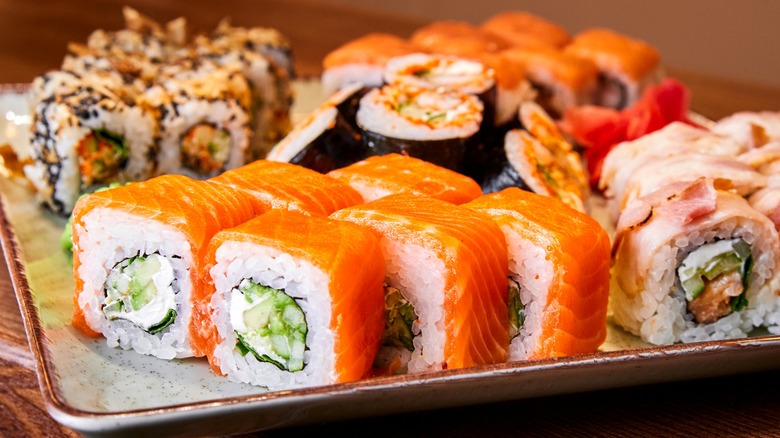What Is The Ideal Temperature For Sushi Rice And How To Nail It Every Time
With as many fans of sushi that exist, it's shocking how few make it at home. After all, making sushi yourself gets you your fill of the dish at a considerable discount compared to the price at a Japanese restaurant (unless you're going against the advice of the late, great Anthony Bourdain and buying discounted sushi). Yes, rolling it can be intimidating at first. But truth be told, what really trips up most folks is cooking the rice to perfection.
Marissa Stevens, recipe developer and founder of Pinch and Swirl, wants folks to feel confident about making sushi at home. To that end, she shared some advice with The Takeout about how to get the rice just right every time. It's important to note that sushi rice isn't just plain white rice. The grains are seasoned with a blend of rice vinegar, sugar, and salt which should only be incorporated when the kernels reach the appropriate temperature. "You want it warm enough to absorb the vinegar mixture but not so hot that it turns sticky or steamy," Stevens said. "If it's too cold, the seasoning doesn't absorb and the texture suffers."
The correct temperature is also paramount for creating an elegant looking roll. "Warm rice is easier to work with — it stays soft and glossy," she said. "Once it cools too much, it firms up and gets a bit stiff." Attaining that ideal Goldilocks not-too-hot, not-too-cold temperature isn't as challenging as it may seem, but it does require adhering to specific steps.
Achieving the perfect temperature for sushi rice
Undercooked rice won't allow you to form a cohesive roll, but when it's overcooked it becomes unappealing mush (it's also a sign you are at a bad sushi restaurant). Thankfully, Stevens isn't just book smart about how to achieve the optimal temperature for sushi rice -– she's practiced the exact steps it takes to accomplish that goal. Steps, plural, is the key. Cooking sushi rice well isn't a set-it-and-forget-it kind of procedure.
"I let it steam in the pot after cooking," said Stevens. "Then season it while it's still warm — not piping hot." Being that 'warm' and 'piping hot' are somewhat subjective, how does one know when it's in the right zone? "If I can touch it comfortably, it's ready."
That's the gist of getting the temperature right, but the details matter. "After cooking, I slide a kitchen towel under the pot lid and let the rice steam for 10 minutes," she continued. "This step finishes the cooking gently and keeps excess moisture from dripping back in." Just like perfectly cooked fish, slow and low wins the race, but the job's not done quite yet. "Then I transfer the rice to a wide bowl, fold in the vinegar mixture, and cover it with a damp cloth while it cools to room temperature. That slow, even cooling helps keep the texture just right for sushi." Now, with the key ingredient in hand, all you need are some nori sheets and sushi-grade fish to make a spicy tuna roll that's on par with your favorite sushi haunt.

